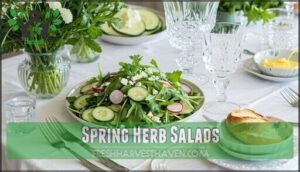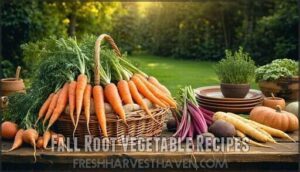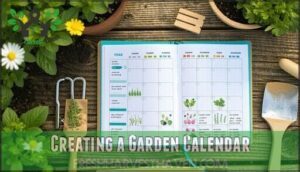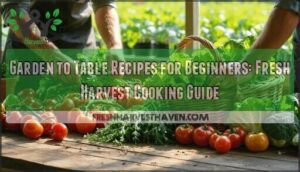This site is supported by our readers. We may earn a commission, at no cost to you, if you purchase through links.
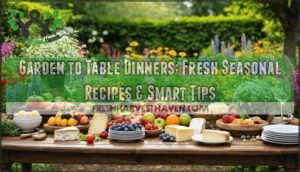 Garden to table dinners transform your kitchen into a celebration of seasonal flavors straight from your backyard or local farm.
Garden to table dinners transform your kitchen into a celebration of seasonal flavors straight from your backyard or local farm.
You’ll discover that fresh-picked tomatoes burst with summer sunshine, while crisp autumn carrots add earthy sweetness to hearty stews.
This approach isn’t just about eating healthier—it’s about reconnecting with nature’s rhythm and creating meals that taste like they’ve been kissed by the earth itself.
Your wallet will thank you too, as seasonal produce costs less and delivers maximum nutrition.
From spring’s tender greens to winter’s robust root vegetables, each season offers its own culinary adventure that’ll make your taste buds dance with joy, filled with earthly sweetness.
Table Of Contents
Key Takeaways
- You’ll maximize flavor and nutrition by harvesting vegetables at peak ripeness and cooking them the same day, capturing up to 63% more vitamin C than store-bought produce.
- You’ll save money while reducing environmental impact by eliminating transportation costs and packaging waste, cutting carbon emissions by up to 5 pounds of CO₂ per pound of food.
- You’ll minimize food waste through smart preservation techniques like freezing herbs in ice cubes, blanching vegetables before storage, and creating flexible recipes that adapt to your garden’s seasonal abundance.
- You’ll develop sustainable eating habits by planning meals around your harvest calendar, using proper storage methods to extend freshness, and embracing seasonal cooking that connects you with nature’s rhythm.
Garden Fresh Dinners
You’ll transform your evening meals when you start cooking with vegetables picked fresh from your garden that same day.
There’s nothing quite like the crisp snap of just-harvested green beans or the sweet burst of a sun-warmed tomato that’s been ripening on the vine until moments before dinner.
Garden sweetness captured in a single bite transforms ordinary dinners into extraordinary celebrations.
Seasonal Produce Selection
How can you transform your backyard bounty into memorable meals? The secret lies in selecting produce at its peak ripeness, when natural flavors sing their loudest.
Fresh picks from your garden deliver unmatched taste and nutrition. By choosing the best seasonal produce guide, you can make informed decisions about your garden to table dinners.
- Spring awakening: Tender greens like spinach and arugula offer delicate, peppery notes
- Summer abundance: Juicy tomatoes and crisp cucumbers burst with sun-soaked sweetness
- Fall harvest: Root vegetables develop deep, earthy flavors after cool nights
Understanding harvest timing and seasonal produce varieties helps you capture each crop’s prime moment. When you embrace seasonal eating patterns, every garden to table dinner becomes a celebration of nature’s perfect timing.
Meal Planning Strategies
Planning garden to table dinners starts with checking what’s ready in your garden today.
Create weekly menus around your harvest, then build grocery lists for missing ingredients.
Use meal scheduling to batch cook seasonal favorites when produce peaks.
Keep recipe organization simple with a garden calendar noting when crops ripen.
Food budgeting becomes easier when you’re growing your own ingredients and planning sustainable meal planning around nature’s timeline.
Reducing Food Waste
Food waste becomes your kitchen’s silent enemy when perfectly good produce spoils.
Smart seasonal cooking transforms potential waste into delicious garden to table recipes through strategic planning and creative preservation methods.
Turn your garden’s surplus into tomorrow’s treasure with simple preservation techniques and flexible recipes that adapt to nature’s rhythm.
Four Essential Waste Reduction Strategies:
- Composting Tips – Turn scraps into nutrient-rich soil for next season’s garden
- Preserving Excess Produce – Freeze, can, or dehydrate surplus harvests immediately
- Zero Waste Cooking – Use stems, leaves, and peels in stocks and seasonings
- Food Recovery Planning – Transform leftovers into new meals within 48 hours
Sustainable cooking means embracing imperfect vegetables and creating flexible recipes that adapt to your garden’s abundance.
When life gives you too many tomatoes, make soup base for winter comfort meals.
By adopting low waste methods, home cooks can substantially reduce their environmental impact while enjoying fresh, seasonal ingredients.
Cooking Techniques Matter
You’ll transform your garden harvest into restaurant-quality meals with the right tools and techniques.
Sharp knives, proper storage methods, and understanding flavor pairings turn simple vegetables into extraordinary dinners that celebrate each season’s unique bounty.
You can achieve this by applying the techniques correctly, and the result will be extraordinary dinners.
Kitchen Tool Essentials
Every chef’s arsenal starts with five essential tools that’ll transform your garden harvest into memorable meals.
Sharp knives slice through tomatoes without crushing their delicate flesh, while sturdy cutting boards provide stable surfaces for chopping fresh herbs.
Mixing bowls toss vibrant salads effortlessly, and measuring cups guarantee perfect seasoning balance.
Storage containers preserve your bounty’s peak freshness between harvest and plate.
Understanding proper cooking techniques is vital for maximizing nutrient retention and flavor in your dishes, and using the right tools ensures perfect seasoning and helps with memorable meals.
Meal Prep and Storage
Your garden bounty needs smart meal prep strategies to maximize freshness and minimize waste.
Store freshly harvested vegetables in proper storage containers, keeping leafy greens crisp in the crisper drawer and root vegetables in cool, dark spaces.
Prep ingredients immediately after picking—wash, chop, and portion produce for quick weeknight cooking.
Organize your freezer with labeled containers for blanched vegetables, herb cubes, and pre-portioned ingredients that’ll transform tomorrow’s dinner prep into a breeze.
Effective food storage relies on using proper storage container solutions to maintain freshness and is a key part of smart meal prep, which involves proper storage to ensure the best results.
Complementary Ingredient Pairing
Once you’ve mastered storage methods, understanding how flavors work together transforms your fresh produce into restaurant-quality meals.
Smart pairing creates deeper tastes while boosting nutrition—like combining orange vegetables with healthy fats to increase beta-carotene absorption by 600%.
Here’s how to create winning flavor profiles:
- Match aromatics with shared compounds – Tomatoes and basil both contain eugenol, creating natural harmony in your garden to table dishes
- Balance textures for interest – Pair creamy avocado with crisp cucumbers, or smooth beet hummus with crunchy radishes
- Boost nutrient absorption – Combine vitamin C-rich bell peppers with iron-packed kale to enhance mineral uptake by 60%
- Layer cultural flavor traditions – Use Mediterranean combinations like tomatoes, olives, and oregano for balanced acid, salt, and aromatics
- Create seasonal bridges – Herbs like rosemary work equally well with fresh summer squash and dried winter legumes
Understanding ingredient synergy helps you create complementary pairings that make seasonal recipes sing.
Your herb blends and spice combinations will naturally enhance each vegetable’s unique character while building complex flavor profiles that celebrate your garden’s bounty.
Seasonal Recipe Ideas
Your garden’s seasonal bounty offers endless opportunities to create memorable meals that celebrate each harvest.
From bright spring herbs to hearty winter vegetables, you’ll discover how timing and technique transform simple ingredients into extraordinary dinners.
Spring Herb Salads
Spring’s arrival brings an exciting opportunity to create vibrant herb salads that celebrate your garden harvest.
These fresh greens offer incredible flavor combinations when paired with seasonal vinaigrettes. Your herb salad becomes a canvas for creativity, mixing tender leaves with bright lemon vinaigrette that enhances every bite.
To create the perfect salad, consider using high-quality herb salad kits that provide a variety of fresh herbs and ingredients.
| Herb Combinations | Best Pairings |
|---|---|
| Parsley + Mint + Dill | Cucumber, radish, feta |
| Basil + Chives + Cilantro | Tomato, avocado, lime |
| Arugula + Oregano + Thyme | Goat cheese, nuts, berries |
Smart gardenfresh salads start with morning harvests when herbs contain peak oils. Mix soft herbs like basil with sturdy ones like parsley for texture contrast. Your spring menu ideas shine when you let these garden treasures speak for themselves through simple salad dressings.
Summer Vegetable Primavera
Summer’s bounty transforms your kitchen into a vibrant culinary playground.
Toss garden fresh zucchini, bell peppers, and summer squash with al dente pasta for incredible Summer Vegetable Primavera.
Create colorful grilled veggie skewers that’ll make your neighbors jealous.
The key to perfect primavera sauce? Let those garden vegetables shine with minimal seasoning and maximum flavor.
Fall Root Vegetable Recipes
As autumn arrives, roasted carrots transform into golden treasures that’ll make your taste buds dance.
Root vegetables like parsnips and beets become the stars of fall harvest recipes when you roast them to perfection.
These root vegetable dishes bring natural sweetness and earthy flavors that capture autumn’s essence beautifully.
Winter Hearty Stews
When winter settles in, you’ll crave meals that warm you from the inside out.
These hearty stews transform your root vegetables into soul-satisfying comfort food that beats the cold weather blues.
Winter stew essentials:
- Root vegetable medley – Carrots, parsnips, and turnips create the foundation
- Winter squash chunks – Butternut or acorn squash adds natural sweetness
- Slow-simmered broth – Let flavors meld for hours
- Fresh herbs – Rosemary and thyme elevate vegetable-based meals
- Hearty grains – Barley or farro makes stews more filling
Benefits of Garden Dining
When you grow your own vegetables and cook them the same day, you’ll taste the difference in every bite while knowing exactly where your food comes from.
This simple practice transforms your kitchen into a hub of fresh flavors, better nutrition, and sustainable living that benefits both your family and the planet.
Environmental Impact Reduction
With every meal you create from your garden, you’re cutting carbon emissions and packaging waste while building a more sustainable future.
Your homegrown tomatoes travel less than a mile instead of 1,500 miles, slashing transportation emissions by up to 5 pounds of CO₂ per pound of food.
| Environmental Benefit | Garden-to-Table Impact | Traditional Agriculture |
|---|---|---|
| Carbon Footprint | Reduces by 2 kg CO₂ per meal | Higher transport emissions |
| Water Usage | 65% less water needed | 50% more water waste |
| Packaging Waste | Eliminates 300 containers/year | 30% of municipal waste |
| Food Waste | 40% longer freshness | Higher spoilage rates |
| Soil Health | Creates carbon sinks | Chemical dependency |
Your sustainable gardening practices turn every dinner into an act of environmental stewardship, proving that zero waste living starts in your own backyard.
Healthier Eating Habits
When you grow your own vegetables, you’re naturally building healthier eating habits that transform your relationship with food.
Fresh produce from your garden encourages mindful eating – you’ll savor each bite, practice better portion control, and reach for healthy snacks like cherry tomatoes or snap peas.
This garden to table approach promotes sustainable living while supporting ideal nutrient balance through regular meal frequency with organic cuisine that nourishes your body naturally.
By adopting a home gardening approach, individuals can experience numerous benefits that extend beyond personal health to environmental sustainability.
Increased Nutrient Intake
The magic of garden-to-table dining transforms your plate into a powerhouse of wholesome nutrition.
Fresh produce from your backyard delivers nutrient dense foods that outshine store-bought alternatives.
- Vitamin retention – Homegrown vegetables contain up to 63% more vitamin C than commercial produce
- Mineral absorption – Compost-enriched soil increases magnesium and iron by 60% in leafy greens
- Antioxidant activity – Morning-harvested vegetables show 15-20% higher antioxidant levels
- Seasonal variety – Rotating crops guarantee broader micronutrient exposure for balanced meals
Cost-Effective Meal Solutions
Your garden transforms into a money-saving powerhouse through strategic meal planning and seasonal recipes.
Budget cooking becomes effortless when you’re harvesting fresh ingredients from your backyard instead of buying expensive store produce.
Grocery hacks include freezing excess vegetables and creating frugal recipes that stretch ingredients across multiple meals.
Garden to table dinners slash food costs while delivering superior nutrition and flavor, making it a complete solution.
Garden to Table Tips
You’ll transform abundant garden harvests into year-round meals with smart preservation techniques and flexible recipe adaptations.
These practical strategies help you maximize your homegrown produce while keeping seasonal cooking simple and enjoyable.
Preserving Excess Produce
When bountiful harvests overwhelm your kitchen, smart preservation methods transform surplus into future meals.
You’ll extend your garden’s gifts through proper freezing methods, canning tips, and food storage techniques that keep flavors intact year-round. Utilizing a freeze dryer process can be an effective way to preserve food.
- Freeze herbs in ice cube trays with olive oil for instant seasoning cubes
- Label containers with harvest dates and contents for organized storage
- Blanch vegetables before freezing to maintain color and nutrients
- Use dehydrating foods methods for space-saving storage solutions
- Try pickling recipes for tangy preserved vegetables that last months
Adapting Recipes to Seasons
Smart cooks know that seasonal cooking means embracing Recipe Flexibility. You’ll swap heavy winter stews for light spring salads, transforming the same base recipe with different Fresh Ingredients.
When your tomatoes ripen in August, that becomes pasta sauce. Come October, root vegetables take center stage.
Meal Adaptation follows your garden’s rhythm, not rigid cookbook rules. Seasonal Flavors guide your choices naturally.
Creating a Garden Calendar
Planning transforms chaotic growing seasons into organized success.
Your garden calendar becomes the backbone of seasonal gardening, helping you master seed scheduling and crop rotation while tracking harvests throughout the year.
- Map your USDA zone’s frost dates to time cool-season crops like spinach 2-4 weeks before last frost
- Schedule succession plantings every 2-3 weeks for continuous lettuce and bean harvests
- Track 3-4 year crop rotation cycles to prevent soil-borne diseases and maintain garden health
- Record harvest dates and yields to identify productivity trends and improve next season’s planning
Minimizing Seasonal Cooking Challenges
Weather fluctuations won’t derail your seasonal menu when you’ve mastered meal adaptation techniques.
Stock versatile fresh ingredients like onions, garlic, and herbs that complement any harvest planning strategy.
These cooking hacks transform unexpected garden bounty into delicious meals.
Seasonal cooking techniques become second nature when you embrace flexibility over rigid meal planning, turning garden to table recipes into culinary adventures with seasonal produce.
By applying low waste methods to your kitchen routine, you can substantially reduce food waste and create more sustainable meals.
Frequently Asked Questions (FAQs)
How do you start a garden-to-table garden?
Starting a garden-to-table garden will transform your dinner table into a vibrant feast of homegrown flavors.
Choose a sunny spot, test your soil, and plant seasonal vegetables like tomatoes, herbs, and leafy greens for maximum freshness.
What vegetables grow best for beginners?
You’ll thrive with reliable, forgiving vegetables like tomatoes, lettuce, radishes, and green beans.
These crops handle beginner mistakes gracefully while delivering fresh flavors that’ll make your first garden-to-table meals absolutely delicious.
How long does homegrown produce stay fresh?
Your homegrown produce stays fresh longer than store-bought since you’re harvesting at peak ripeness. Leafy greens last 3-5 days, while root vegetables like carrots keep for weeks when stored properly.
Can you garden-to-table in small spaces?
Who needs rolling estates when you’ve got creativity?
You’ll transform balconies, windowsills, and countertops into productive mini-farms using containers, vertical systems, and herb gardens that’ll make store-bought produce weep with envy.
Whats the best soil for vegetable gardening?
Well-draining soil with rich compost works best for most vegetables.
You’ll want a pH between 0-0 for ideal nutrient uptake.
Mix in organic matter like aged manure to feed your plants naturally.
Conclusion
Research suggests that people who embrace garden to table dinners consume 30% more nutrients than those eating store-bought produce.
You’ve learned to harness each season’s bounty, from spring’s tender asparagus to winter’s robust squash.
Your kitchen’s become a canvas where fresh ingredients paint vibrant, flavorful meals that nourish both body and soul.
These garden to table dinners prove that eating well doesn’t require complicated recipes—just respect for nature’s timing and your own creativity in the kitchen.
- https://garden.org/special/pdf/2014-NGA-Garden-to-Table.pdf
- https://islandgardens.com/farm-to-table-a-look-at-the-trends-and-challenges-of-eating-local
- https://ciderpresslane.com/blog/2018/2/22/5-tips-to-host-your-own-garden-to-table-dinner
- https://www.upfrontandbeautiful.com/post/garden-to-table-menu-planning
- https://risegardens.com/blogs/communitygarden/why-to-live-garden-to-table


